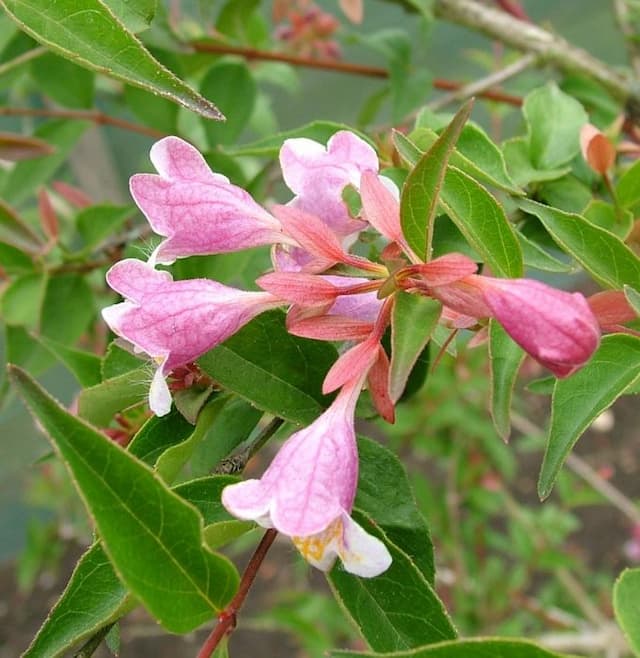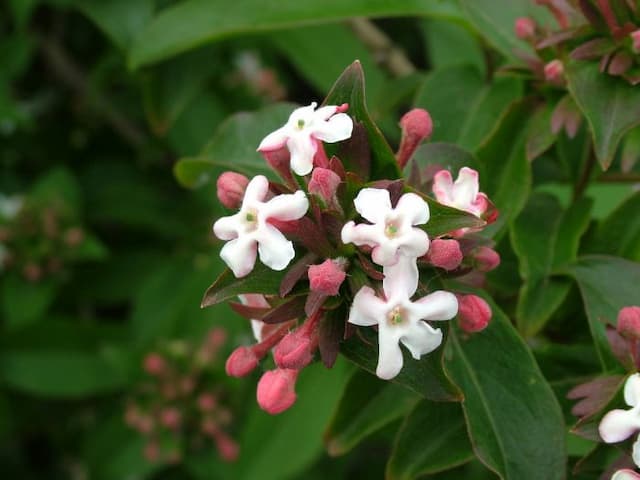Glossy Abelia Abelia 'Edward Goucher'

ABOUT
Abelia 'Edward Goucher' is a graceful shrub that displays a mix of attractive features throughout the seasons. It is adorned with slender branches that arch elegantly and carry glossy green leaves. The leaves have a slightly ovate shape and may exhibit a light bronze hue when they emerge, shifting to a deeper green as they mature. In the warmer months, this abelia variety becomes a focal point in the garden with its profusion of small, bell-shaped flowers, which are typically a soft lilac or pale pink color, adding a delicate splash of pastel hues to its surroundings. These flowers are funnel-like and attractive to various pollinators, including bees and butterflies. As the seasons change, the foliage can take on a purple tinge, providing continued interest even as the blooming period comes to an end. The overall appearance of Abelia 'Edward Goucher' is one of a refined shrub with a loose and slightly informal habit, making it a versatile choice for garden landscapes where year-round aesthetic appeal is desired.
About this plant
 Names
NamesSynonyms
Edward Goucher Abelia, Pink Abelia, Glossy Abelia.
Common names
Abelia x grandiflora 'Edward Goucher', Abelia 'Edward Goucher'
 Toxicity
ToxicityTo humans
Edward Goucher Abelia is not known to be toxic to humans. There are no widespread reports of poisoning or adverse reactions in humans upon ingesting parts of this plant. Therefore, accidental ingestion of the Edward Goucher Abelia is unlikely to cause harm. However, it's essential to be cautious since individual reactions to plants can vary.
To pets
Edward Goucher Abelia is not considered toxic to pets. It is generally regarded as safe for cats, dogs, and other domestic animals, with no significant toxicity noted should pets ingest the plant. As with humans, it is always best to monitor pets for any unusual reactions after ingestion, but typical consequences are minimal or non-existent.
 Characteristics
CharacteristicsLife cycle
Perennials
Foliage type
Semi-deciduous
Color of leaves
Green
Flower color
Lilac-pink
Height
3-5 feet (0.91-1.52 meters)
Spread
3-5 feet (0.91-1.52 meters)
Plant type
Shrub
Hardiness zones
6-9
Native area
China
Benefits
 General Benefits
General Benefits- Ornamental Appeal: Edward Goucher Abelia is appreciated for its beautiful pink flowers and attractive foliage, adding visual interest to gardens.
- Drought Tolerance: Once established, this shrub demonstrates moderate resistance to drought, reducing the need for frequent watering.
- Low Maintenance: Requires minimal pruning and care, making it ideal for gardeners of all skill levels.
- Attracts Pollinators: The flowers of the Edward Goucher Abelia attract bees, butterflies, and other beneficial insects, promoting biodiversity.
- Long Blooming Period: It has a lengthy flowering season from late spring to fall, providing long-lasting color in the landscape.
- Versatility in Landscaping: This shrub can be used for a variety of landscaping purposes including hedges, borders, and as a foundation planting.
- Deer Resistance: Edward Goucher Abelia is not a preferred food source for deer, which helps to prevent damage to the shrub.
- Compact Size: With a moderate growth habit, it is suitable for smaller gardens or spaces where a more controlled plant size is desired.
 Medical Properties
Medical PropertiesThis plant is not used for medical purposes.
 Air-purifying Qualities
Air-purifying QualitiesThis plant is not specifically known for air purifying qualities.
 Other Uses
Other Uses- Abelia Edward Goucher can be trained as a small tree for bonsai, offering a miniature garden aesthetic due to its small leaves and attractive flowers.
- Its branches can be used in floral arrangements, providing a long-lasting green backdrop and subtle fragrance.
- As a dense shrub, it can serve as a natural privacy screen for outdoor living areas or between properties.
- Edward Goucher can be shaped into topiary forms for ornamental garden features or hedge mazes.
- The plant acts as a natural habitat and food source for butterflies, thus playing a role in butterfly gardening.
- Its arching stems allow it to be used as a living archway or garden entrance when planted in a series and trained overhead.
- The flowers can be used for crafting potpourri due to their color and gentle fragrance, adding a natural scent to rooms.
- When planted along slopes or banks, its root system can help prevent soil erosion due to its spreading, dense nature.
- The Abelia's foliage can provide textural contrast in cut leaf collages or flat lay art photography.
- Its dried branches and leaves can be incorporated into rustic crafts or as part of natural decorative wreaths for doors and walls.
Interesting Facts
 Feng Shui
Feng ShuiEdward Goucher Glossy Abelia is not used in Feng Shui practice.
 Zodiac Sign Compitability
Zodiac Sign CompitabilityEdward Goucher Glossy Abelia is not used in astrology practice.
 Plant Symbolism
Plant Symbolism- Longevity: Abelia is known for its long blooming season, symbolizing endurance and the ability to thrive over time.
- Attraction: With its delicate pink flowers, it is often associated with allure and magnetism, which may symbolize an attractive character or an inviting environment.
- Adaptability: This plant's versatility in various landscapes represents adaptability and the ability to adjust to different life situations.
- Renewal: Abelia 'Edward Goucher' often rejuvenates itself by growing new shoots, which can symbolize new beginnings or rebirth.
- Grace: The arching branches and elegant foliage can be seen as a symbol of gracefulness and poise.
 Water
WaterEdward Goucher Abelia prefers consistent moisture, but it is important to avoid overwatering. Water the plant deeply once a week, providing about 1 gallon of water per session to ensure the root zone is thoroughly moistened. During hot, dry periods, increase watering frequency to twice a week. In cooler months or when rainfall is sufficient, reduce watering. Always check the top few inches of soil before watering; if it's dry, it's time to water, but if it's still moist, wait a day or two.
 Light
LightEdward Goucher Abelia thrives best in full sun to partial shade. The ideal spot for this plant is an area where it can receive at least 4 to 6 hours of direct sunlight daily, with some dappled shade during the hottest part of the afternoon. This ensures vibrant foliage and abundant flowering.
 Temperature
TemperatureEdward Goucher Abelia is hardy and can tolerate a wide temperature range; however, it grows best between 60°F and 75°F. This plant can typically survive winter temperatures down to about 5°F and can handle summer temperatures up to 95°F without significant stress, making it suitable for a variety of climates.
 Pruning
PruningPrune Edward Goucher Abelia to maintain its shape and encourage bushier growth; the best time for this is late winter or early spring before new growth starts. Pruning can be done annually, and any dead or diseased branches should be removed as soon as they are noticed to keep the plant healthy and attractive. Light pruning can also be done after flowering to improve the plant's appearance.
 Cleaning
CleaningAs needed
 Soil
SoilEdward Goucher Abelia thrives in a well-draining soil mix, high in organic matter with a pH range of 6.0 to 7.5. For best results, mix garden soil with compost and peat moss to improve fertility and drainage.
 Repotting
RepottingEdward Goucher Abelia is typically grown outdoors and does not require frequent repotting. If grown in a container, repot every 2 to 3 years or when it becomes root-bound.
 Humidity & Misting
Humidity & MistingEdward Goucher Abelia prefers moderate humidity but is quite adaptable and can tolerate the typical range found in most outdoor environments.
 Suitable locations
Suitable locationsIndoor
Provide bright light, well-draining soil, and moderate water.
Outdoor
Plant in sunny to part-shade, fertile, well-drained soil.
Hardiness zone
6-9 USDA
 Life cycle
Life cycleEdward Goucher Abelia begins its life cycle as a dormant seed until favorable conditions trigger germination, typically in the warmth of late spring or early summer. The sprouting seedling develops roots and shoots, relying on the stored energy within the seed until it can produce its own food through photosynthesis. As a young plant, it focuses on vegetative growth, producing a bushy mass of stems and leaves that harden off to withstand varying environmental conditions. Entering the reproductive stage, Edward Goucher Abelia blossoms in summer, featuring small, tubular pink flowers that attract pollinators and result in the formation of seed capsules if fertilization occurs. After the blooming period, the plant may produce seeds which disperse to start a new cycle, although propagation is often through cuttings rather than seeds. Throughout its life cycle, which can span several years, the plant experiences periods of active growth and dormancy, responding to seasonal changes in temperature and day length.
 Propogation
PropogationPropogation time
Spring-Early Summer
The optimal time for propagating Abelia 'Edward Goucher', also known simply as Edward Goucher Abelia, is typically in late winter to early spring just before new growth begins. The most popular method for propagation is semi-hardwood cuttings. For semi-hardwood cuttings, you would select a healthy portion of the plant's stem that has begun to mature but is not fully hardened, typically from the current season's growth. You cut a 4- to 6-inch (10 to 15 cm) section of stem that includes several leaves and use a rooting hormone on the cut end to encourage root growth. The cutting should then be planted in a well-draining soil medium and kept in a warm, humid environment until it develops roots, after which it can be transplanted into the garden or a more permanent pot.






![Himalayan honeysuckle [Golden Lanterns]](/_next/image?url=https%3A%2F%2Fplants-admin.emdemapps.com%2Fimages%2Fplants%2F%2Fimages%2F604b55302cc87.png&w=640&q=75)


